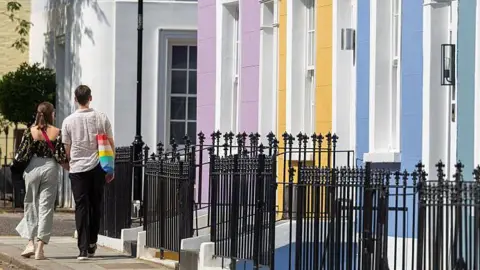Wage growth slows slightly over summer
Emer MoreauBusiness reporter
 Getty Images
Getty ImagesWage growth in the UK cooled slightly over the summer, as unemployment ticked up marginally.
Average wage growth was 4.7% in the three months to August, down from 4.8% over the three months to July, according to new data from the Office for National Statistics (ONS).
The national unemployment rate rose slightly from 4.7% to 4.8%.
Analysts said the data indicated that the UK jobs market was stabilising after a year of volatility.
Job vancancies fell by 9,000, or 1.3%, in the three months to September, and the ONS said this was the 39th consecutive period in which job openings had fallen compared to the previous three months.
Liz McKeown, the ONS’s director of economic statistics, said: “After a long period of weak hiring activity, there are signs that the falls we have seen in both payroll numbers and vacancies are now levelling off.”
Youth drive unemployment
Ms McKeown said the ONS was seeing different patterns among age groups, adding “the increase in unemployment was driven mostly by younger people.”
There was a quarterly drop in the number of people who were economically inactive because they were students or retired, but this was largely offset by a rise in economic inactivity for other reasons, including long-term illness and for other reasons.
Danni Hewson, AJ Bell’s head of financial analysis, said the figures were creating “a clearer picture of a labour market that’s soft, with younger workers facing the biggest challenges”.
She said the decision by Chancellor Rachel Reeves to raise employer national insurance “made it more expensive for employers who had lots of part-time staff, many of them being younger workers dipping their toe in the labour market for the first time”.
“The fact the ONS has found that the rise in unemployment in the three months to August was driven mostly by younger people suggests those warnings have become reality,” Ms Hewson said.
“Making it harder to find these types of jobs could have a marked impact on their relationship with work in the future.”
The ONS has said the unemployment rate should be treated with caution and it is taking additional steps to address concerns about the quality of the data.
‘Steady labour market’
Annual growth in workers’ average earnings was 6% for the public sector and 4.4% for the private sector.
Private sector earnings growth was the lowest in four years but was still ahead of inflation.
The ONS said the public sector annual growth rate is affected by some public sector pay rises being paid earlier in 2025 than in 2024.
Chris Hare, the senior UK economist at HSBC, said the data indicates “a fairly steady labour market”.
“I think we’re probably seeing fairly soft demand for labour in the economy,” he said, adding that it should lead to “a gradual easing in broader cost pressures in the labour market and an easing in wage growth”.
The number of people who were made redundant between June and August increased from the same period last year, to 3.8 per 1,000 employees in June to August 2025.
The ONS also revised the previous figure for wage growth, bringing it up from 4.7% to 4.8%.
This figure will likely be used to calculate the increase to the state pension for next year.
Under the triple lock policy, the state pension is increased by the highest of wage growth, inflation or 2.5%.
‘Paltry’ real wage growth
Inflation currently stands at 3.8%, meaning that real wage growth – how much better off workers are when accounting for rises in the cost of living – is 0.9%.
Responding to the figures, the Liberal Democrats said that real wage growth is barely keeping up with inflation.
Similarly, the Resolution Foundation said real wage growth was “paltry”, and that real weekly wages have only increased by £1.50 since last September — “barely enough to cover the cost of a Greggs sausage roll”.
Charlie McCurdy, an economist at the think tank, said: “The UK’s longstanding weakness in the jobs market has finally caught up with pay packets.
“The deteriorating labour market, coupled with persistently high inflation, means that cost of living pressures are likely to build over the autumn.”






